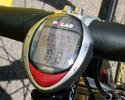
Recently on Cyclingnews.com |
Race Tech: Giro d’Italia, June 2, 2007
Broadcasting the beats
By Shane Stokes
Rider watching has become a whole lot more revealing in recent years as audiences watching the Giro d’Italia can now get closer to the riders than ever before. Viewers still can’t quite get inside their heads, but certainly inside their chests; during each stage of the race, it’s possible to follow the heart rate readings of some of the world’s top riders and see what kind of effort they are putting out. Forget posture, pedaling style, and facial expressions - keeping track of their tickers makes it easier to see who is flying and who is fading.
"We sponsor eleven ProTour teams," said Jason Crowe of Polar Italy. "Liquigas, Saunier Duval [Prodir], Crédit Agricole, Cofidis, Française des Jeux, T-Mobile, Gerolsteiner, Rabobank, Quickstep [Innergetic], Caisse d’Epargne and Euskaltel [Euskadi]. Over half the bunch rides with us, and during the race people can track just how the riders are doing."
Each day on this year’s Giro, up to four riders are selected and monitored during the stage. Heart rate, speed and altitude are recorded and then transmitted, after which it is available to be seen by viewers on screen and at the Polar Cycling web site.
"The rider wears his normal transmitter so they don't have to put anything special on," explains Crowe, an Irishman who has been living in Italy for the past decade. "They can then use the watch or the computer on the handlebars, as usual. There is another type of transmitter which goes either in their pocket or under the saddle, whichever they prefer. This also receives the heart rate information and has a GPS sensor in it, so we get the heart rate, we get the speed and the altitude, plus the direction."
Having the data, however, is just the first part of the process. "Inside this device there is a SIM [card], like a mobile phone," he continues. "It sends the information via GPRS (General Packet Radio Service) to a server. We can access the server from the Internet, download the information in real time, and then pass it on to the TV guys so they can put it on the screen."
According to Crowe, the information was first transmitted on the Tour de France four years ago. For the past three years the GPRS version has been used, making the process easier. The device is relatively light, "approximately 70 or 80 grams," he says.
Of course, four riders out of a whole bunch is a small percentage. Careful selection maximises the chances that one or more of those could be involved in the action on the day in question.
"We choose the riders on a day-by-day basis, in relation to what kind of stage it is," he says. "We figure out if it is going to be a day for the sprinters, the climbers or the breakaway. We also talk to the teams, finding out who is feeling well, who wants to do something.
"It is a little bit about guesswork, but it is also down to having good relations with the teams because they have an insight into what is going to happen. They know who is going to try and go up the road. Obviously there are no guarantees, you can't be sure who is going to be in the break, but they have a good idea about it and we work from there."
The net result is a fly on the [chest]wall view of what is happening in the bunch. Short of hacking into the team radios, it’s perhaps the best way of estimating what pressure a rider is under during a given stage of the race.
Photography
For a thumbnail gallery of these images, click here
Images by Shane Stokes/Cyclingnews.com
- Gilberto Simoni is one of Polar's star riders , and his CS400 computer has accompanied the Saunier Duval-Prodir rider on each stage of this year's Giro d'Italia.
- Polar's Jason Crowe with one of the chest straps which sends the rider's EKG signal wirelessly to both his usual computer as well as a supplemental unit which forwards the information to Polar.
- A closer view of the belt. Soft edges and materials makes the strap comfortable to wear.
- Crowe with the transmitter , which forwards the data via an built-in SIM card.
- A close up of the transmitter. According to Crowe, the unit weighs only 70-80g. Given the ease with which the UCI mandated weight limit is broken these days, gadgets like these are no longer viewed as a weight penalty by the riders.






